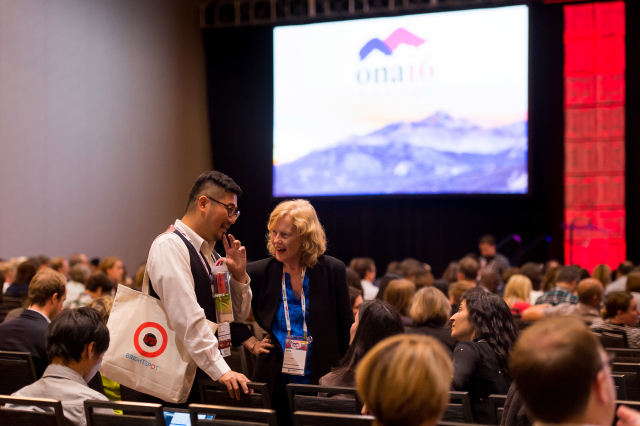This post was written by Charo Henríquez, Senior Editor of Digital Storytelling and Training at The New York Times, who will be leading our First Timers’ Orientation on the opening day of ONA17.
You may have heard the stories, seen the tweets, videos and pictures from previous years, but now it’s your turn to attend ONA’s annual conference. Wondering how to prepare for your first time there? Here are some helpful tips.
Make a plan
First up, it’s always a good idea to check out the official ONA17 schedule in advance and find sessions and speakers that pique your interest. Think about those things you are working on, the ones you are passionate or just curious about. You can look at complete tracks, such as Career Building or Audience Engagement + Analytics, or pick and choose the sessions that suit you. For easier planning, you should use the conference app. This will allow you to personalize your schedule and receive alerts on your phone about any updates for changes at the conference. You’ll also receive a printed version of the program with your swag bag at registration so, as you can see, you’ll have many options.
We have a great session planned for ONA conference newbies called You’re #1: First Timers’ Orientation where we will give you some more helpful tips on how to navigate the event, as well as a head start in connecting with all sorts of interesting people. Our goal is to help you make the most of your week. Be prepared to learn and have a good time.
Pro tip: Some sessions fill up quickly, so plan to arrive early, and have a backup activity or session to attend at that time in case your first choice isn’t available.
Make connections
Do you have friends or colleagues who are also attending? Great! You can plan to go to sessions together or divide and conquer. If you’re flying solo, don’t worry. ONA is a place where you can make great connections with a very diverse group of people that share some of your interests and concerns.
If you’re looking for work, you’re in luck! There will be many recruiters and hiring managers looking for talent at the conference. Be ready to talk about your background and experience, but also be sure to ask questions and interact.
Pro tip: Some people think networking is all about shaking hands, distributing business cards, providing copies of your resume or sharing LinkedIn contact info. While exchanging contact information is helpful, approaching people with meaningful questions and a real interest in sharing ideas is always best. Don’t think about what you can get out of the conversation, but what you can bring to it. Chances are you’ll make a better impression that way.
Another pro tip: Also, don’t be a “badge glancer.” Those are people who look at name tags and only walk up to people who work at the “right places.” Worse yet are those who avoid eye contact while someone is talking to them because they are scanning the badges around the room for other people to approach. When you are talking with someone, be present! Don’t be on your phone or looking around the room for someone “more interesting.” Engage people in conversation, if only for a little while, and try to learn more about them.
Breathe
If you are an introvert or just not that comfortable with the social aspect of the conference, that’s alright too. Don’t let FOMO get the best of you and drain all your energy on day one. Give yourself time to breathe, see some sights around the city, recharge in your room or in a quiet corner at the venue. Then, come back to the sessions, talks and keynotes when you’re ready.
One last tip: If you haven’t yet, go join the ONA17 Facebook group and follow @ONAconf and @ONA on Twitter for updates and to connect with other attendees before we meet up in Washington, D.C..
Can’t wait to see you there! Don’t forget to check out our packing guide as well.
 Charo Henríquez is Senior Editor of Digital Storytelling and Training at The New York Times. She has over 16 years of experience working in the intersection of journalism, technology, and product management as well as training and coaching journalists. She is an advocate for women, Hispanics and underrepresented communities in media.
Charo Henríquez is Senior Editor of Digital Storytelling and Training at The New York Times. She has over 16 years of experience working in the intersection of journalism, technology, and product management as well as training and coaching journalists. She is an advocate for women, Hispanics and underrepresented communities in media.
Edited by Laura Bertocci.


